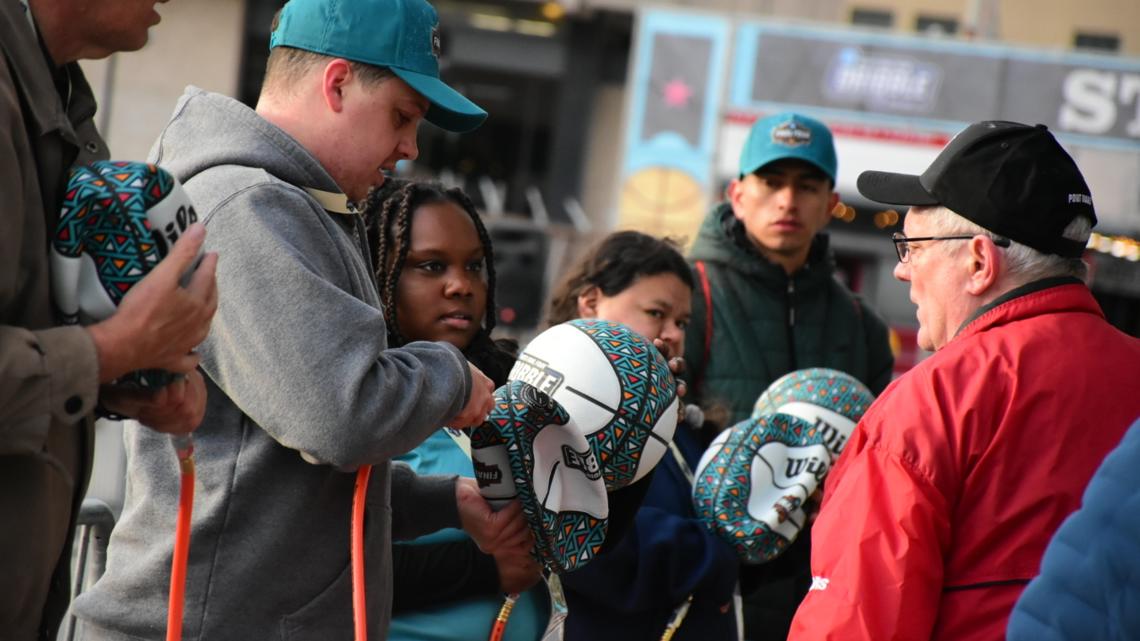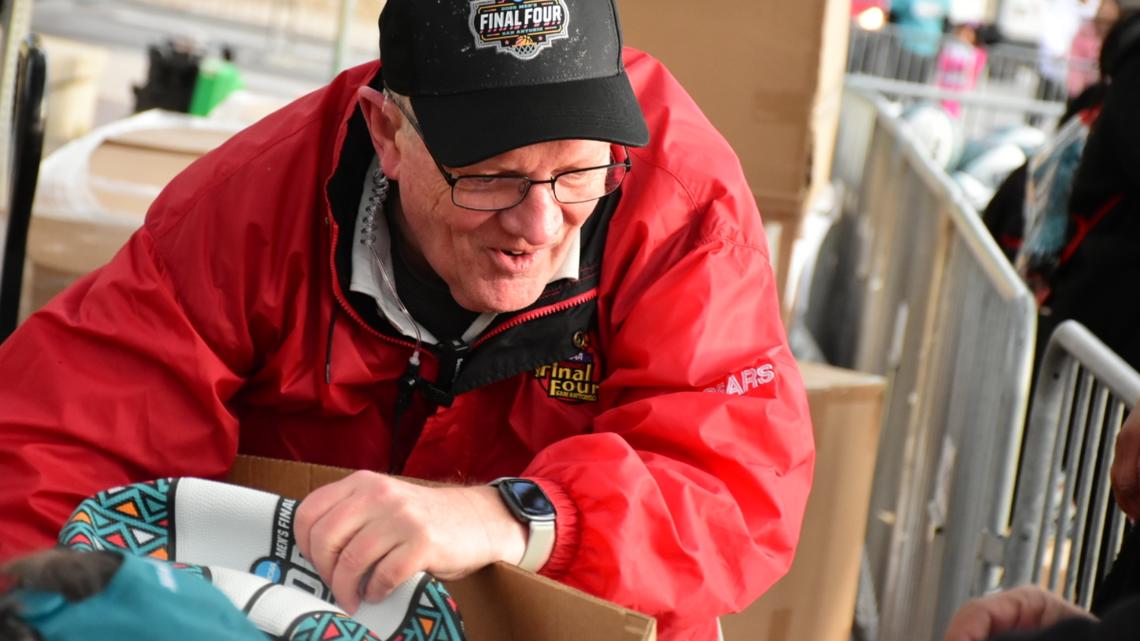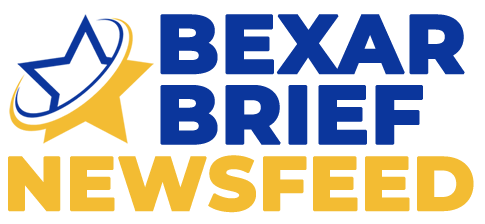Randy Bear oversaw the very first Final Four Dribble in 2002. More than two decades later, it’s still his to plan when the event is in San Antonio.
SAN ANTONIO — Mere hours after Houston beat Duke in a comeback, home-state, David-vs.-Goliath win that rocked the Alamodome, a different kind of Final Four drama was unfolding Sunday.
Only this is one that Randy Bear has been game-planning and executing successfully on and off for 23 years.
At about 6:30 a.m. on the coldest morning of Final Four weekend in San Antonio, as the sun was just starting to poke through the clouds, Bear and about 25 other volunteers gathered in a small fenced-off area at Travis Park. A dozen or so air hoses sat splayed out in front of them. Also nearby were several boxes—some big, some small, all containing tightly packed deflated basketballs.
About 3,200 deflate basketballs, to be exact.
And it was up to Bear and these volunteers to pump them them up – to turn them from the shape of smooshed cantaloupes into glorious, bouncy globes – so they could be handed off to hundreds of excited kids participating in the Final Four Dribble event, set to start in a few hours’ time.
“There’s a kid behind every one of those basketballs this year,” Bear said, adding he believed 3,200 basketballs was the most ever for what’s become a marquee Final Four family event.
Come 10 a.m., this fenced-off area would become an impressive ball “corral,” with a pile and then a mountain of Final Four-branded basketballs as tall as the volunteers themselves.


‘We were so naive’
Bear – who now lives in Arkansas after working at USAA’s San Antonio headquarters for more than two decades – holds the rare distinction of having been a volunteer at every Final Four hosted by the Alamo City. That goes back to 1998, when he played the part of host for the visiting college all-stars’ West Team.
“At practice, they wanted me to do a shootaround with them,” Bear recalls. “And I kept thinking, ‘How am I going to stand up to these guys that are All-Stars?’”
Four years later, when the women’s Final Four came to town for the first time, the NCAA decided it wanted to try something new: A Dribble event that will give 2,002 local kids the experience of dribbling their way through a course.
The local organizing committee knew who they wanted to oversee the very first iteration of the event. They tapped Bear to oversee the operation.
What they didn’t know yet at the time was how best to actually carry out the inflation. They brought a handful of “high school basketball pumps” and got them ready to go…
“We were so naive,” Bear now recalls with a smile. “We burned them out in 15 minutes.”
But they didn’t leave the kids disappointed. They adapted on the fly, using trucks to haul balls over to the Alamodome where volunteers and staff worked to inflate them, before bringing the now-pumped-up basketballs back to the starting line.
The event start on time. The hoopers-in-training got their balls.
But if Bear was going to keep planning for the Final Four Dribble, it would have to be out with the basketball pumps.
“After that I decided, ‘This is not gonna work,’” he says.
The men’s Final Four was scheduled to return in 2004. By then, Bear had come up with his new system: An “inflation rig” comprised of air hoses attached to a compressor or two. A system fit for blowing up thousands of balls in a couple hours rather than a device you’d keep in the garage to pump up the family’s ball every couple months.


It was “extremely successful.” And it’s endured as the same system Bear and San Antonio Sports uses every time the Final Four returns to the city.
It’s a little bit of creativity that prevents Bear from having to plan a logistical nightmare.
“We’re the only Final Four that actually inflates them the day of the event. All the others do it the night before or day before, and then they have to haul all of these basketballs over to the event,” he said. “We decided against that… and with the number of volunteers here in San Antonio, that makes it really easy.”
That may be changing, however. Also at Travis Park on Sunday morning was a team from Indianapolis – which has been bestowed Final Four hosting duties for 2026 – to see firsthand how the job can be streamlined when the Dribble hits their streets.
Speaking with Mary Ullman Japhet, who is overseeing Final Four operations this year, Bear said the Indy team expected it would take a week to inflate 3,000-some basketballs.
Japhet could only smile.
“This is an example of the impact of Final Four beyond the court,” she said of the Dribble. “The games are exciting – the games last night were crazy-exciting – but this is where we can bring the Final Four to the community.
A reliable game plan
Fast-forward to 2025, and Bear’s process is as impressive as any Final Four head coach’s offensive schemes.
On Sunday morning, about a dozen people were inflating while others made sure they made it into the pile (don’t need a stray ball rolling around to trip anyone up).
The process was down to a science. Within about 30 seconds, any given volunteer would pick a chunky piece of rubber out of the box, pop it with the inflation needle, get it full of air and – after a few important test dribbles – toss it towards the growing mound.
Three hours of anywhere from 10 to 12 “inflaters” at a time making 3,200 basketballs Dribble-ready… you do the math. One of the jacket-wearing volunteers working all morning was too in his groove to keep a personal tally.
“I kept count for the first five or 10…” he said, following it up with a smile and a shrug.
No matter. The evidence of the work was the increasingly awe-inspiring mountain of teal and white growing a few steps away. If you were one of the volunteers standing by to make sure the mountain remained a mountain and not a sea, you’d better be looking up: At any moment a ball or two or five could be flying your way.
PHOTOS: What does it take to inflate 3,200 basketballs for the Final Four Dribble?
Andrea Loza, one of the volunteers who inflated dozens of basketballs, remembers being a participant in 2004. That year, she says, the Dribble rounded the perimeter of the Alamodome instead of snaking its way through downtown.
She said it was cool to be in this position now, seeing what it took to create her memories from a different angle.
The sun eventually emerged, shining on a growing Travis Park crowd. As Mount Basketball went from growing to dwindling, the balls ending up in kids’ hands, one parent could be heard saying, “When they said 3,000 basketballs… there’s literally a pile of basketballs!”
Bear himself was nearby, overlooking the corral, a smile on his face after another job well done.
“The coolest thing is to see the kids out there with these basketballs,” he said. “They’re usually doing other things at the park, and then all of a sudden it comes time and they see that corral, and their eyes just light up.”
Soon after, hundreds of families set out in waves from the starting line of the one-mile Dribble course, the symphony of bouncing balls on Travis Street making it sound like you had shrunk and fallen into an industrial popcorn popper. The fun officially got underway at 10 a.m., and it had warmed a few degrees by then too.
But stroll by the park at the crack of dawn and you’d have seen firsthand an example of the behind-the-scenes work it takes to pull off Final Four hosting duties. Sometimes it’s younger volunteers wanting to see the Final Four from a different angle. Sometimes it’s oft-returning ones like Bear – who on this day wore a hat reading “Point Guard” on the back – who was probably asleep by the time the Alamodome roared at the Houston Cougars’ win, his mind trained on making memories for young basketball fans.
By 8 a.m. on Sunday, cheerleaders from UIW had started to arrive, as did the entertainers and food trucks. The aroma of breakfast tacos and coffee soon began making its way through Travis Park, although walk anywhere near Bear’s basketball corral and you’d get hit with the strong waft of freshly inflated synthetic rubber.
The DJ was also getting set up around this time, closer to the center of the park than the inflation-expert volunteers were. What was the first song that blared out? Appropriately, the Black Eyed Peas’ “Pump It.”
